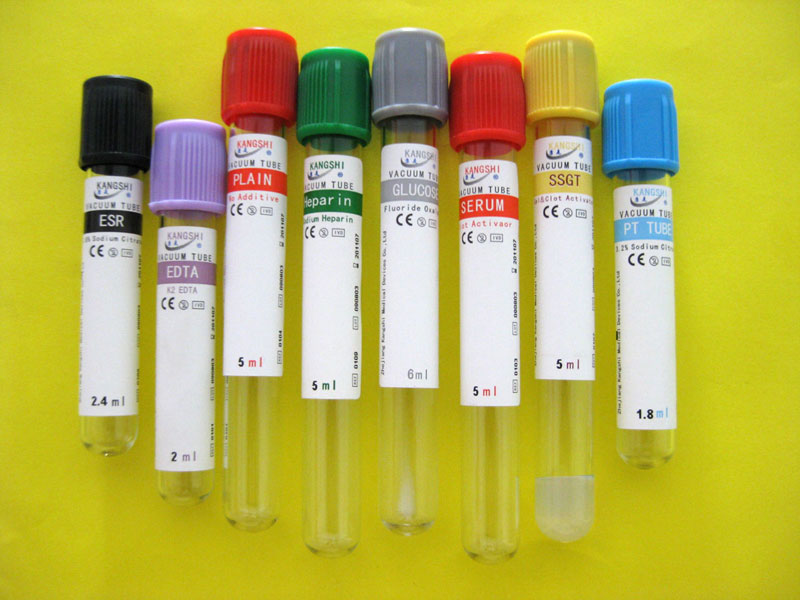Blood collections is one of the basic step taking as a
medical personnel particularly with at the level of the Laboratory
department but blood collection tubes is another confusing part of this whole
process.Many students are unable to specify which tube with its
corresponding anticoagulant are used for various laboratory tests.So these
article will help identifying the various test tubes and their corresponding
anticoagulant including the test used for.
The evacuated tube system for blood collection in use for
various laboratory tests consists of tubes of various sizes, with particular
colored caps indicating tube contents. Most blood collection tubes contain
additive that either accelerates clotting of blood (clot activator)
or prevents the blood from clotting that's is anticoagulants.
Knowing these various test tubes and their corresponding anticoagulant or clot activator is very beneficial and ease blood collections and blood sample processing minimizing random errors.
So below are the most commonly used blood collection tubes including their respective additives and uses in blood collection and processing:
|
Various blood collection tubes and their respective
anticoagulants
1. BLACK
Additive: Sodium
Citrate
·
Function: Forms calcium salts thats is binds calcium in the blood. Calcium is
required for blood clotting. Since it is bound up the blood cannot
clot resulting in a whole blood sample
·
Laboratory uses: Erythrocyte sedimentary Rate (ESR)
2. LAVENDER OR PURPLE
These tubes are generally
used for haematology tests inorder to update whole blood for analysis
blood film for abnormal cells or malaria parasites, reticulocytes, red cell
folate, Monospot test for EBV, parathyroid hormone (PTH)
3. RED
|
|
Plain tubes with no additive
|
They are used for biochemistry
tests to obtain serum
·
Additive: None or contains silica particles which act as clot
activators.
·
Function: Clot activator promotes blood clotting with glass or
silica particles.
·
Laboratory Uses: Serum testing mostly Biochemistry (glucose,
cholesterol, triglycerides, HDL, potassium, amylase, alkaline phosphatase, BUN,
CK, liver enzymes), blood bank, serology (RH Typing, Antibody screening, Red
Cell Phototyping, DAT, RPR, monospot, rheumatoid factor, ANA)
4. GREEN
|
Heparin test tube
|
·
This less commonly used bottle is
for biochemistry tests which require heparinised plasma or whole blood for
analysis.
·
Additive: Heparin (Sodium/Lithium/Ammonium)
·
Function: Inhibits thrombin formation to prevent clotting
·
Laboratory uses: Chemistry Testing (Plasma determinations in chemistry) :
ammonia, carboxyhemoglobin & STAT electrolytes, chromosome screening,
insulin, renin and aldosterone
5. GREY
|
Sodium fluoride test tube
|
·
Additive: Potassium oxalate and Sodium fluoride
·
Function: Sodium fluoride acts as an antiglycolytic agent to ensure
that no further glucose breakdown occurs within the sample after it is taken.
Potassium oxalate removes calcium and acts as an anticoagulant.
·
Laboratory uses: Chemistry testing, especially glucose(sugar) and lactate,
Glucose tolerance test (GTT)
6. YELLOW

·
Additive: anticoagulant SPS (Sodium Polyanetholsulfonate) &
ACD (acid citrate dextrose)
·
Functions: Prevents the blood from clotting and stabilizes bacterial
growth.
·
Laboratory Uses: Blood and bodily fluid cultures (HLA, DNA, Paternity)
Tubes with SPS – For Blood and bodily fluid cultures (HLA, DNA, Paternity). The SPS aids in the recovery of microorganisms by slowing down/ stopping the actions of complement, phagocytes, and certain antibiotics.
Tubes with ACD are for cellular studies, HLA typing, paternity testing.
Tubes with SPS – For Blood and bodily fluid cultures (HLA, DNA, Paternity). The SPS aids in the recovery of microorganisms by slowing down/ stopping the actions of complement, phagocytes, and certain antibiotics.
Tubes with ACD are for cellular studies, HLA typing, paternity testing.
7. ROYAL BLUE

·
Additive: Sodium Heparin also Sodium EDTA
·
Function: Inhibits Thrombin formation to prevent
·
Laboratory uses: Chemistry trace elements (such as Zinc, Copper, Lead and
Mercury), toxicology, and nutritional chemistry testing
8. LIGHT BLUE
the
blue bottle is used for hematology tests involving the clotting system,
which require inactivated whole blood for analysis.
·
Additive: Sodium Citrate
·
Function: Binds and remove calcium to prevent blood from clotting
·
Laboratory uses: Coagulation (clotting process-P.T)
PT (Prothrombin Time – evaluates the extrinsic system of the coagulation cascade & monitors coumadin therapy)
APTT/ PTT (Activated Partial Thromboplastin Time – evaluates the intrinsic system of the coagulation cascade & monitors heparin therapy)
FDP (Fibrinogen Degradation Products)
TT (Thrombin Time)
Factor assays
PT (Prothrombin Time – evaluates the extrinsic system of the coagulation cascade & monitors coumadin therapy)
APTT/ PTT (Activated Partial Thromboplastin Time – evaluates the intrinsic system of the coagulation cascade & monitors heparin therapy)
FDP (Fibrinogen Degradation Products)
TT (Thrombin Time)
Factor assays








